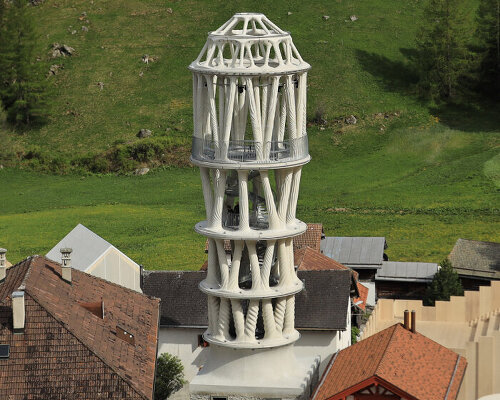3D printed White tower surfaces using soft concrete
The remote village of Mulegns in the Swiss Alps has welcomed the dubbed tallest 3D printed white tower in the area, Tor Alva. Unveiled on May 20th, 2025, it is the Origen cultural foundation that led the work in collaboration with ETH Zurich. From May 23rd onwards, the 3D printed white tower is open every day for guided tours. Then, starting July 2025, the space can host staged performances. Tor Alva plans to stay in Mulegns for around five years. After that, it can be dismantled and re-erected elsewhere, but there’s no news yet on where it can head next.
The construction of the White Tower in the remote village of Mulegns in the Swiss Alps began on February 1st, 2024, with the introduction of 3D printed columns of the Tor Alva architecture. The first 8 columns of the lower floor were 3D printed by a robot that extruded soft concrete into multilayered print paths at ETH in Zurich, resulting in a series of joint-based, twisting hollow columns for the White Tower. The 3D printed architecture requires no framework, while the necessary steel reinforcement was inserted in the robotic production process.
all images courtesy of Michael Hansmeyer and Benjamin Dillenburger | photo by Birdviewpicture
Inside the process of the 3D printed white tower
The White Tower, or Tor Alva in Mulegns, Swiss Alps, is designed by architects Benjamin Dillenburger and Michael Hansmeyer. The Digital Building Technologies group of ETH Zurich is developing the tower’s technology in collaboration with the Institute of Structural Analysis and Design (CSBD) and the Institute of Building Materials (PCBM) in the context of the National Competence Center Digital Fabrication. Based on the timeline that Michael Hansmeyer detailed, the 3D printed White Tower had its columns assembled in May 2024.
3D printing became the main tool that realized the architecture of the White Tower. Soft concrete emerged as the key ingredient, and as the robot extruded thin layers of soft concrete through a nozzle, it instinctively directed itself to form geometric, hollow columns until it reached a certain height. The material, being soft concrete, was malleable enough to bond to form homogeneous components. As soon as it hardened, which it did quite quickly, it supported the successive freshly layered extrusion. The design team says that by saving mass and cement, the 3D printing process can also entail a reduction in the carbon emissions generated during production.
the remote village of Mulegns in the Swiss Alps has welcomed Tor Alva | photo by Birdviewpicture
3D printed Tor Alva as an artistic and cultural space
At 30 meters high, including the base, the White Tower may take home the crown for being the tallest 3D printed building in the world. Another feature that the design team highlights comes through the absence of the formwork, given that the concrete is not poured in 3D printing but rather layered in extruded strips by a robot. Adding to this, dismantling the 3D printed White Tower can be easy. In fact, the design team has this in their minds since they might think of rebuilding Tor Alva someplace else after serving its five-year life in the Swiss Alps. It helps that the architecture has a modular design that allows the individual components to be easily assembled and dismantled, and be connected using removable screws instead of adhesives.
Diving into the project’s background, the 3D printed White Tower, or Tor Alva, rises at 30 meters along the Julien mountain in the remote village of Mulegns, Switzerland. It is designed for Fundaziun Origen, functioning as a space for art installations, music, and theater performances. The recently printed hollow columns echo the central interior of the architecture, with the facade being windowless and open, adorned by the criss-cross structure natural to the 3D printing process. The White Tower presents itself as the byproduct of computational design, digital fabrication, structural engineering, and materials science, gradually emerging from the use of soft concrete extrusion.
the tower was unveiled on May 20th, 2025 | photo by CheWei Lin
From the get-go, the 3D printed White Tower already embodies an installative character. If this springs as the first thought, then treating it as a venue for intimate concerts, art affairs, and cultural mediation becomes complementary. Glancing at its design, Tor Alva consists of 32 branching columns that wrap around a series of abstract and atmospheric rooms. From the ground, visitors ascend through the vertical stairs, and once they reach the top floor, the vaulted concert venue greets them alongside the panoramic horizon across the Julier valley. The design team says that the White Tower’s characteristics are reminiscent of the craftsmanship of the master builders of the Baroque era in Grison, brought to life again by 3D printing.
The story was updated on May 21st, 2025, to announce the opening of the tower.
inside the Tor Alva | photo by Benjamin Hofer
the construction began on February 1st, 2024 | photo by Nijat Mahamaliyev
the first columns were 3D printed by a robot | photo by Michael Hansmeyer and Benjamin Dillenburger
the 3D printed architecture requires no framework | photo by Nijat Mahamaliyev
view of Tor Alva during construction | photo by Andrei Jipa
view of the White Tower in village of Mulegns | photo by Benjamin Hofer
at night, the tower lights up | photo by Michael Hansmeyer and Benjamin Dillenburger
project info:
name: White Tower / Tor Alva
architects: Benjamin Dillenburger, Michael Hansmeyer
technology: Digital Building Technologies of ETH Zurich, Institute of Structural Analysis and Design, Institute of Building Materials
location: Mulegns, Switzerland, on the Julier Pass
The post tor alva, the tallest 3D printed tower in the world, opens in the swiss alps appeared first on designboom | architecture & design magazine.

